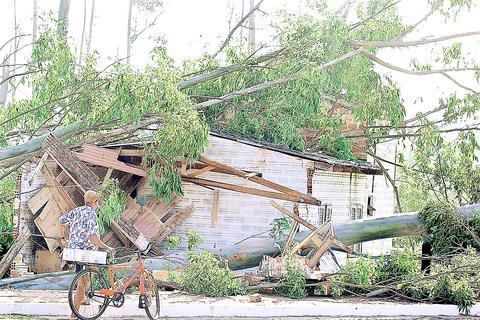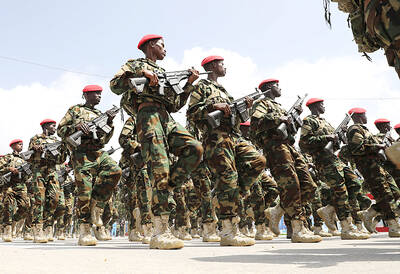A whirling storm battered the coast of southern Brazil, killing two people, injuring at least 39 others and destroying hundreds of homes, civil defense officials said.
American meteorologists said winds exceeded 120kph, making the storm the first hurricane on record in the South Atlantic. Brazilian scientists originally disagreed, but on Sunday they acknowledged the winds could have been as high as 150kph -- well above hurricane strength.
Brazil has never seen a hurricane, and residents said they were terrified when the storm roared ashore early Sunday about 840km southwest of Rio de Janeiro, pounding homes with heavy rains and wind.

PHOTO: AFP
"It was like hammering on the houses," said Athaide Cambruzi, who lives in the resort town of Icara. "I saw seven beach houses literally smashed by the wind and the water."
Authorities were searching for 11 fishermen missing off the coast of Santa Catarina state after two boats sank 15km offshore in 4m-high waves early Sunday, Navy Commander Paolo Baltore said.
The storm cut phone lines to many towns, and the number of injuries was expected to rise as reports trickled in from those areas, said Marcio Luiz Alves, an official with the Santa Catarina state Civil Defense.
The storm damaged an estimated 20,000 homes in Santa Catarina, destroying 500 of them completely. That left about 1,500 people homeless and forced as many as 15,000 to flee their homes, Alves said.
In the town of Ararangua, at least 5,500 houses lost their roofs, said firefighter Sergeant Carlos Carvalho. Shelters were being set up in schools.
"We've never seen anything like this," he said.
The storm, dubbed Catarina by meteorologists, hit the coasts of Santa Catarina and Rio Grande do Sul states late Saturday with heavy rains and high winds. It was dissipating over land late Sunday.
On Saturday, meteorologists from the Brazilian Center for Weather Forecasting and Climatic Studies were calling the storm an "extra-tropical cyclone" with estimated winds of 80-90kph.
But the US National Hurricane Center in Miami estimated the storm was a full-fledged, Category I hurricane with central winds of 121-129kph. A private US forecasting company, AccuWeather, said it also considered the storm a hurricane.
On Sunday, Brazilian scientists acknowledged they were surprised by the intensity of the storm. Brazil has no wind-measuring devices in the affected areas, and both the American and Brazilian scientists said they were basing their estimates on satellite data.
Marcelo Moraes, a meteorologist at the Integrated Climate Center of Santa Catarina state, said winds could have reached 150kph. Hurricanes begin at 120kph.
Near the city of Criciuma in Santa Catarina state, a tree smashed into a car and killed the driver, officials said. His wife was seriously injured. At least 34 others also were injured throughout the state, the civil defense said.

ELECTION DISTRACTION? When attention shifted away from the fight against the militants to politics, losses and setbacks in the battlefield increased, an analyst said Recent clashes in Somalia’s semi-autonomous Jubaland region are alarming experts, exposing cracks in the country’s federal system and creating an opening for militant group al-Shabaab to gain ground. Following years of conflict, Somalia is a loose federation of five semi-autonomous member states — Puntland, Jubaland, Galmudug, Hirshabelle and South West — that maintain often fractious relations with the central government in the capital, Mogadishu. However, ahead of elections next year, Somalia has sought to assert control over its member states, which security analysts said has created gaps for al-Shabaab infiltration. Last week, two Somalian soldiers were killed in clashes between pro-government forces and

Ten cheetah cubs held in captivity since birth and destined for international wildlife trade markets have been rescued in Somaliland, a breakaway region of Somalia. They were all in stable condition despite all of them having been undernourished and limping due to being tied in captivity for months, said Laurie Marker, founder of the Cheetah Conservation Fund, which is caring for the cubs. One eight-month-old cub was unable to walk after been tied up for six months, while a five-month-old was “very malnourished [a bag of bones], with sores all over her body and full of botfly maggots which are under the

BRUSHED OFF: An ambassador to Australia previously said that Beijing does not see a reason to apologize for its naval exercises and military maneuvers in international areas China set off alarm bells in New Zealand when it dispatched powerful warships on unprecedented missions in the South Pacific without explanation, military documents showed. Beijing has spent years expanding its reach in the southern Pacific Ocean, courting island nations with new hospitals, freshly paved roads and generous offers of climate aid. However, these diplomatic efforts have increasingly been accompanied by more overt displays of military power. Three Chinese warships sailed the Tasman Sea between Australia and New Zealand in February, the first time such a task group had been sighted in those waters. “We have never seen vessels with this capability

‘NO INTEGRITY’: The chief judge expressed concern over how the sentence would be perceived given that military detention is believed to be easier than civilian prison A military court yesterday sentenced a New Zealand soldier to two years’ detention for attempting to spy for a foreign power. The soldier, whose name has been suppressed, admitted to attempted espionage, accessing a computer system for a dishonest purpose and knowingly possessing an objectionable publication. He was ordered into military detention at Burnham Military Camp near Christchurch and would be dismissed from the New Zealand Defence Force at the end of his sentence. His admission and its acceptance by the court marked the first spying conviction in New Zealand’s history. The soldier would be paid at half his previous rate until his dismissal